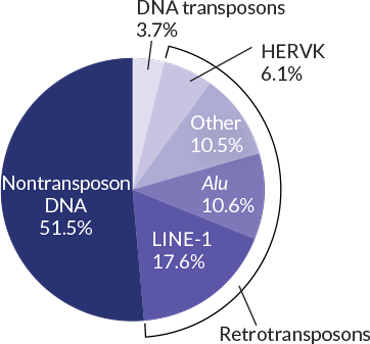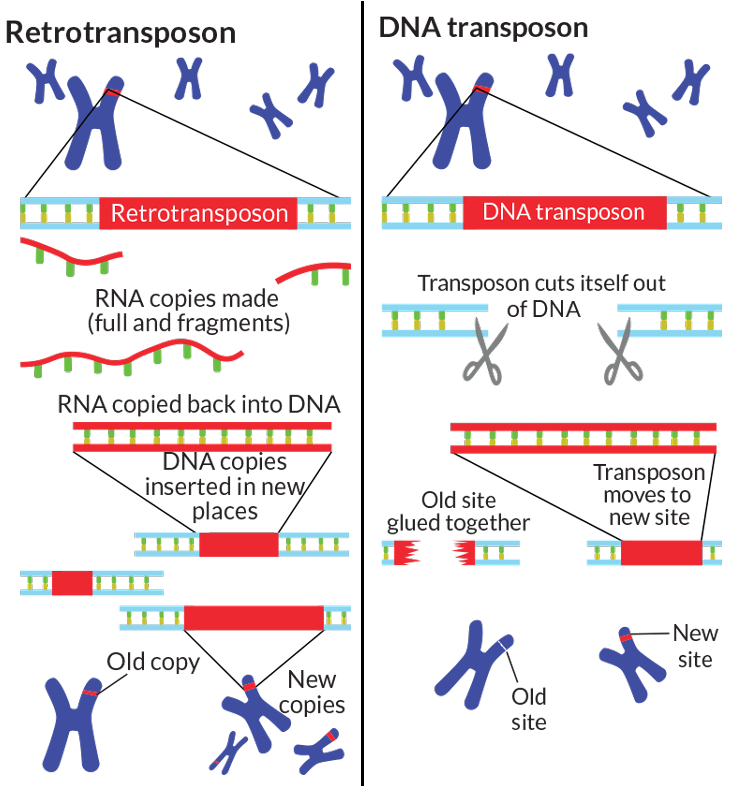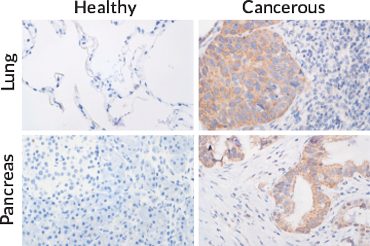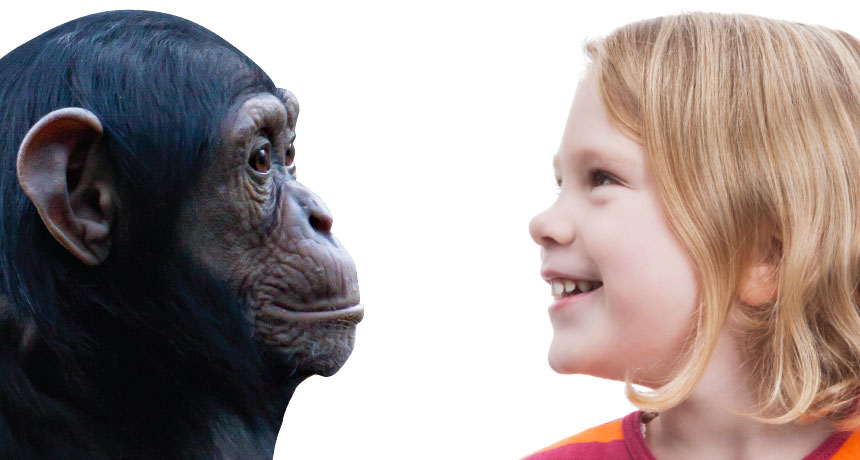
THE DIFFERENCE Humans and chimpanzees are easy to tell apart, even though they share a primate ancestor. Jumping genes helped sculpt their distinctions.
DIAMOND IMAGES PHOTOGRAPHY/ISTOCKPHOTO; SRBOZUK/ISTOCKPHOTO
Face-to-face, a human and a chimpanzee are easy to tell apart. The two species share a common primate ancestor, but over millions of years, their characteristics have morphed into easily distinguishable features. Chimps developed prominent brow ridges, flat noses, low-crowned heads and protruding muzzles. Human noses jut from relatively flat faces under high-domed crowns.
Those facial features diverged with the help of genetic parasites, mobile bits of genetic material that insert themselves into their hosts’ DNA. These parasites go by many names, including “jumping genes,” “transposable elements” and “transposons.” Some are relics of former viruses assimilated into a host’s genome, or genetic instruction book. Others are self-perpetuating pieces of genetic material whose origins are shrouded in the mists of time.
“Transposable elements have been with us since the beginning of evolution. Bacteria have transposable elements,” says evolutionary biologist Josefa González. She doesn’t think of transposons as foreign DNA. They are parts of our genomes — like genes.
“You cannot understand the genome without understanding what transposable elements are doing,” says González, of the Institute of Evolutionary Biology in Barcelona. She studies how jumping genes have influenced fruit fly evolution.
Genomes of most organisms are littered with the carcasses of transposons, says Cédric Feschotte, an evolutionary geneticist at the University of Utah in Salt Lake City. Fossils of the DNA parasites build up like the remains of ancient algae that formed the white cliffs of Dover. One strain of maize, the organism in which Nobel laureate Barbara McClintock first discovered transposable elements in the 1940s, is nearly 85 percent transposable elements (SN: 12/19/09, p. 9). Corn is an extreme example, but humans have plenty, too: Transposable elements make up nearly half of the human genome.
Most of the transposons in the genomes of humans and other creatures are now “dead,” meaning they are no longer able to jump. The majority are in bits and pieces scattered throughout the genome like so much confetti. Many researchers used to think these broken transposons were just genetic garbage.
Far from junk, however, jumping gene remnants have been an evolutionary treasure trove. Some of the control switches transposons once used for their own hopping have been recycled over time into useful tools that help species, including Homo sapiens, adapt to their environments or take on new characteristics.
Repurposed transposon parts are at the very heart of what makes humans human, says Gennadi Glinsky, a cancer biologist at the University of California, San Diego. Some of the first genes to turn on in early human embryos are transposon remains that now help direct embryonic development. We humans also owe parts of our immune system, and perhaps our brainpower, to transposable elements.
“Without them, we simply wouldn’t exist,” Glinsky says.
Story continues after slideshow
Colorful effects
Transposons have shaped the evolution of nearly every organism on Earth. Here are just a few examples of their effects.
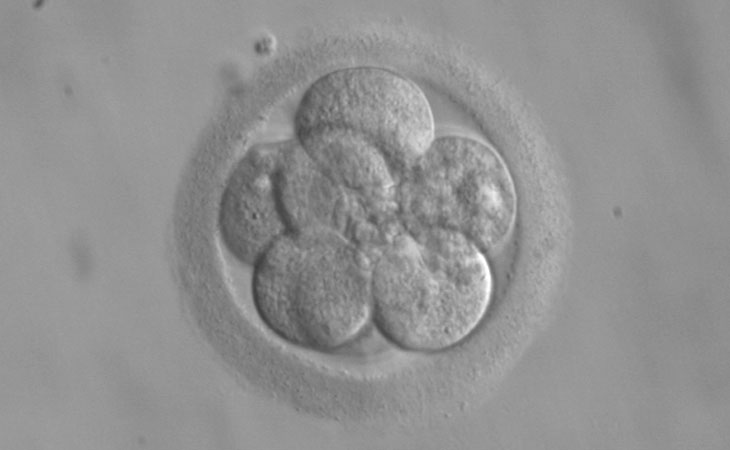
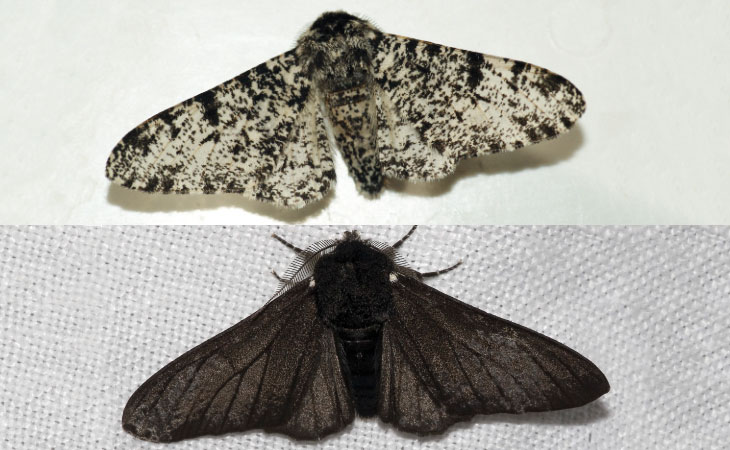

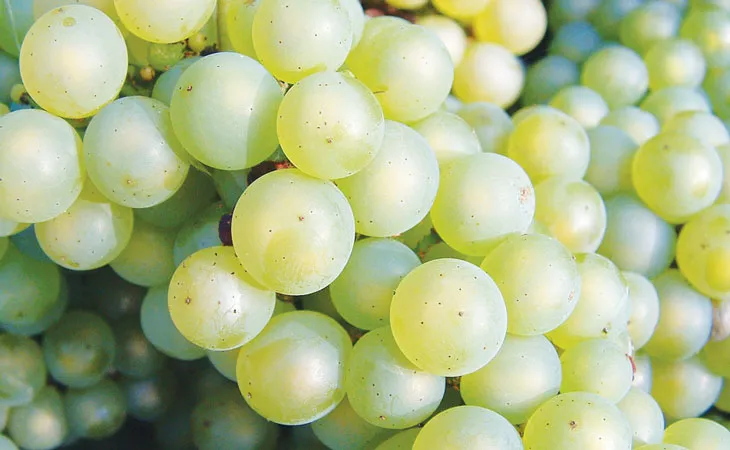
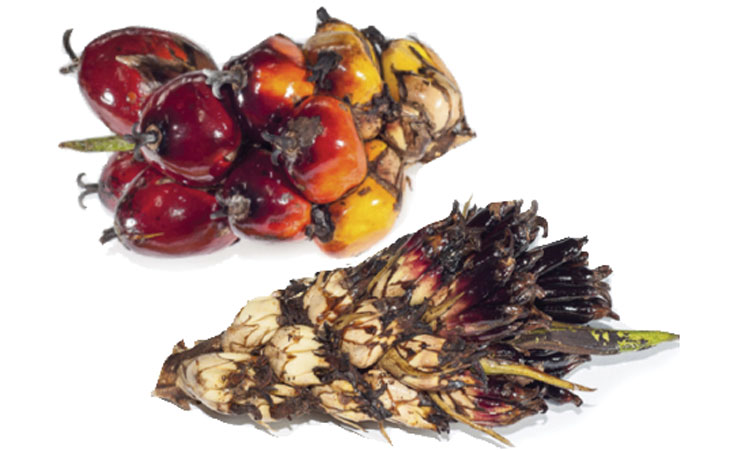
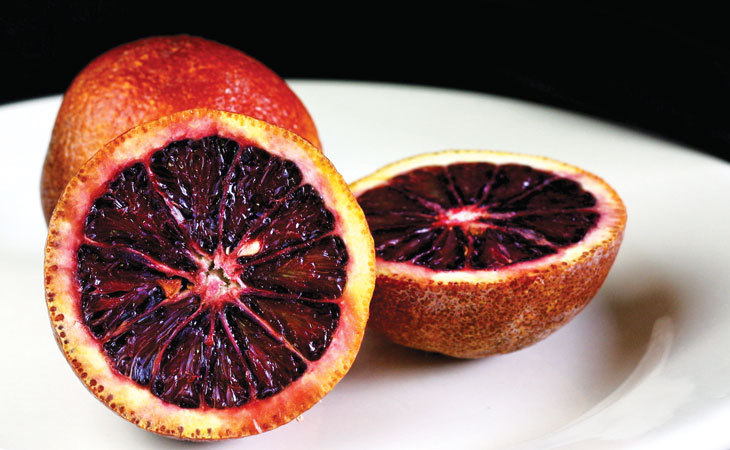
Sources: D. Lisch/Nature Reviews Genetics 2013; E.B. Chuong, N.C. Elde and C. Feschotte/Nature Reviews Genetics 2017.
Propagating parasites
The evolutionary benefits might delude some people into thinking that transposons are friends, but don’t be fooled, Feschotte says. “They are not there to make us happy.” Transposons have only ever served one purpose: to make more of themselves.
Transposons have two main ways of propagating: copy and paste or cut and paste. Retrotransposons — many of which were once RNA viruses called retroviruses — are the copy-and-pasters. They insert into an organism’s DNA, get copied into many RNA replicas and then use a special enzyme called a retrotransposase to convert the RNA copies back into DNA. Those DNA duplicates can hop into different spots in the genome. Retrotransposons, the most common type of transposable element in humans, make up about 45 percent of the human genome.
Instead of making copies, DNA transposons use the cut-and-paste method to move around the genome. To hop, they slice themselves out of the DNA and move to a new location. Sometimes cells make copies of these transposons while attempting to repair damage created when the transposons sliced the DNA. But because they don’t actively copy themselves, DNA transposons are greatly outnumbered by retrotransposons, making up only about 4 percent of the human genome.
Story continues after diagram
Like any invader, a live transposon can spell problems for its host. Both types of transposons may disrupt important genes as they bounce around the genome, says pathologist Kathleen Burns. As far as scientists know, there’s only one living transposon left in the human genome, says Burns, of Johns Hopkins University School of Medicine. A retrotransposon known as LINE-1, or long interspersed element-1, is still hopping. It has deposited so many copies of itself that it accounts for about 18 percent of the human genome. Another transposon called an Alu element can’t move on its own, but it gets around by hitching rides from LINE-1.
“If LINE-1 is a parasite of the genome, then Alu is a parasite’s parasite,” says John Moran, a geneticist at the University of Michigan in Ann Arbor. And a very successful one. Each person carries more than 1 million spots where an Alu element has landed, leaving behind a full or partial copy of itself. All together, scattered bits and pieces of Alu make up about 11 percent of human DNA. “Just by sheer mass alone they’ve contributed greatly to the size of our genome,” he says.
LINE-1 and Alu aren’t prolific bounders. Even when they do move, most LINE-1 and Alu hops are inconsequential, Burns says — but not always. Scientists have long known that when LINE-1 jumps into a gene called APC, it can disrupt the gene and lead to colon cancer. A jump that disrupts a gene encoding a blood-clotting protein called factor VIII can cause the bleeding disorder hemophilia A. Production of one of LINE-1’s proteins called ORF1p is a hallmark of cancer, Burns and colleagues reported in 2014 in the American Journal of Pathology.
As pancreatic tumors grow and evolve, they collect LINE-1 insertions, Burns and colleagues reported in Nature Medicine in 2015. On average, the pancreatic cancer patients examined in the study carried 15 LINE-1 insertions in their tumor DNA that were not in healthy tissue. Some people carried no new insertions, others had up to 65.
Cancer isn’t the only disease in which LINE-1 and Alu are suspects. In brain cells, Alu has repeatedly jumped into DNA associated with a gene called TOMM40. Alu’s shenanigans may keep TOMM40, which helps cellular power plants called mitochondria run, from doing its job. That could put stress on cells with weakened mitochondria, making them vulnerable to degenerative diseases such as Alzheimer’s, geneticist Peter Larsen of Duke University and colleagues proposed February 24 in Alzheimer’s & Dementia.
But transposon jumping might have a plus side. “We believe that some level of activity is important for a healthy brain,” says neuroscientist and geneticist Jennifer Erwin.
LINE-1 hops frequently in the human brain, Erwin found while at the Salk Institute for Biological Studies in La Jolla, Calif. She and colleagues examined DNA from individual brain cells taken from three donated human brains and tested bulk samples from the hippocampus (an area important for learning and memory) and the frontal cortex (where most thinking and decision making is thought to happen).
Brain cells in those areas did not have identical DNA. LINE-1 jumped to new places in some cells or was removed from places in others, the team reported last year in Nature Neuroscience. LINE-1 variations affect 44 to 63 percent of cells in the brain, the researchers estimated.
Some transposon hopping may be a reaction to stress, says Erwin, now at Johns Hopkins University. “We think of it as a way for the genome to adapt to unknown pressures and environments.” Each jump is a bit of a gamble, with potentially good or bad consequences, she says. But rolling the dice with transposon hopping may allow brain cells to develop capabilities not initially encoded in the genome. Those new capacities may influence behavior, thinking and personality.
Glinsky goes further, contending that transposons help individualize people. Even identical twins may have genetically different brain cells because of transposon hopping after the embryo splits, he says. Thanks to jumping genes, “Every time a human baby is created, you make an individual that can never be replicated.”
Most of the 950,000 or so copies of LINE-1 in the human genome are partial copies or contain mutations that put an end to their jumping. Only about 100 are full copies that actually jump. Eventually, natural selection or chance may rid the genome of damaging insertions, leaving the partial, inactive LINE-1 skeletons (or Alu) scattered throughout the genome. All other human transposable elements have already met that fate.
Story continues after image
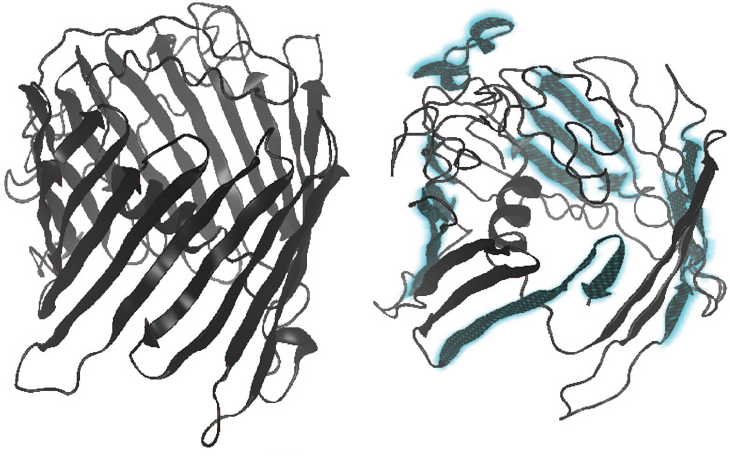
Valuable fossils
Human genomes are veritable boneyards of transposon fossils. But even relics that no longer jump can still have an effect on human evolution. Some of those fossils have been passed down from very early human ancestors. Some were inherited from ancestors of all four-limbed vertebrates. Those jumping genes got stuck in the ancient host’s DNA hundreds of millions of years ago. By now, their fossils are mere shards, torn apart in the natural shuffling of DNA as each generation bequeaths slightly different genetic combinations to its heirs. Some of those shards have proved useful, helping to shape important novelties, such as pregnancy in mammals (SN Online: 1/29/15).
“These elements have a lot to do with genome innovation,” says Ting Wang, a geneticist at Washington University in St. Louis. Some long-dead transposon remnants have been transformed into both small and large RNAs. Not the kind that encode proteins, but RNAs that help boost or dampen protein production and gene activity in cells, and have been linked to health and disease (SN: 8/28/10, p. 18). Like flea market furniture, old transposons have been up-cycled into at least 409 small RNAs called microRNAs, Sheng Qin of Nanjing Normal University in China and colleagues reported in PLOS ONE in 2015. Other researchers have found that more than 30 percent of long noncoding RNAs — which carry out several different jobs in the cell, most still unknown — are repurposed transposable elements (SN: 12/17/11, p. 22). A plethora of other small RNAs were originally transposable elements themselves, but have now been co-opted to keep transposons from jumping.
RNAs aren’t the only valuable salvage items humans have pulled from the transposon junk pile. Some proteins recycled from jumping gene parts have also proved extremely useful, especially for the immune system. Researchers had long suspected that two DNA-cutting enzymes called RAG1 and RAG2 are encoded by relics of a DNA transposon, but no one had ever found a transposon that uses those proteins to slice and hop out of a spot, says immunologist Anlong Xu of Sun Yat-sen University in Guangzhou, China.
The enzymes are important because they generate antibodies and other immune proteins needed to recognize and kill an ever-changing variety of infectious organisms. Working with small, fishlike and jawless creatures called lancelets, Xu and colleagues found a DNA transposon called ProtoRAG, an evolutionary relative of the genes for the mammalian immune system’s RAG1 and RAG2. The finding suggests the DNA transposon that gave rise to the two enzymes jumped into an ancestor of lancelets and jawed vertebrates about 550 million years ago. The transposon was passed down generation after generation until jawed vertebrates borrowed the RAG enzymes to make new immune proteins, Xu and colleagues proposed last summer in Cell.
Better than scratch
Perhaps the most valuable scraps in the transposable element junk heap are bits of DNA called transcription factor binding sites. Transcription factors are proteins that help control gene activity, usually turning it up a notch or two. Each type of transcription factor recognizes and binds to a certain sequence of DNA. Upon binding to DNA, transcription factors work with other proteins to stimulate the process of copying DNA instructions into RNA to ultimately make proteins.
Transcription factors control genes in complex networks reminiscent of the electronic circuits that drive computers. Such circuits would be very difficult to evolve from scratch, Wang says. Thanks to transposons, humans didn’t have to.
Retrotransposons are littered with transcription factor binding sites, which might be expected for entities that make their living by getting copied into RNA over and over again. Broken transposons can provide raw materials that over time become complex gene-regulating switches. Many of the transcription factor binding sites important for controlling human and mouse genes may have come from transposable elements, research by Wang and colleagues suggests.
Some of these recycled transposon bits may have helped humans fight viruses. About 45 million to 60 million years ago, a retrovirus called MER41 invaded the genome of a primate ancestor of humans. Today, humans have hundreds of copies of the now-extinct retrovirus scattered about their genomes. Other mammals, such as lemurs, vesper bats, carnivores and even-toed ungulates, have MER41 relatives in their genomes, too, Feschotte and colleagues reported last year in Science.
What’s important about the discovery is that MER41’s bits and pieces include binding sites for transcription factors involved in fighting infections. Those transcription factors are alerted to infection by an immune system chemical called interferon gamma. The researchers speculate that the retrovirus may have used the interferon gamma signal to boost its own production. But over time, the mammalian hosts turned that weapon against the virus.
By reconfiguring genetic circuits, transposons have helped to make humans uniquely human, Glinsky says. Rewiring gene activity in humans happened, in part, when transposons inserted themselves into the genomes of human ancestors after the split from chimpanzees, he reported last year in Genome Biology and Evolution. Remains of the transposons that infected humans have been recycled into more than a thousand regulatory switches found only in humans, he discovered.
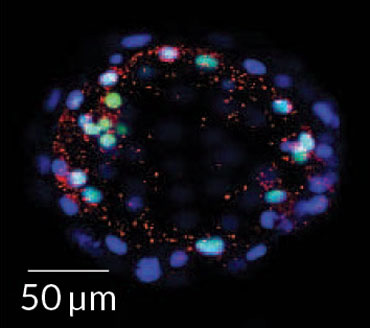
Early in development, though, the silencing tape is ripped away, leaving genes unmarked and ready for action. Some of the first genes to start expressing themselves again are former viruses turned into transposable elements known as human endogenous retroviruses, particularly one called HERVK, Wysocka and colleagues found. HERVK is the youngest class of endogenous retroviruses: They were last active as viruses within the last 200,000 years. Those glory days are long gone. HERVK can no longer make infectious viruses because each copy of the virus has some mistake that renders it harmless. But some of HERVK’s damaged genes can still make proteins, albeit defective ones. And some of those defective proteins may actually assemble into viruslike particles that can help protect human embryos, Wysocka and colleagues reported in 2015 in Nature.
Those viruslike particles may activate a primitive virus-fighting system that could help defend embryos from other, more dangerous infections before the immune system or placenta are available to do so, Wysocka thinks. That sounds like a possible evolutionary game-winner, but Wysocka says there are other options. The system “could be an evolutionary accident that human development now has to cope with,” she says. But regardless of its evolutionary role, scientists need to understand what retroviruses and other transposons are doing to shape human development.
Wysocka and colleagues have found evidence of transposons sculpting human faces. The researchers used cells from humans and chimpanzees that had been reprogrammed to behave like stem cells. Those reprogrammed stem cells were then coaxed to become cranial neural crest cells, which help form the face. Examining gene activity in these cells allowed Wysocka and colleagues to do “cellular anthropology” to figure out how human and chimp facial development differs, the team reported in Cell in 2015.
The researchers discovered that hundreds of gene regulatory switches known as enhancers are used differently in the two species. Many of those enhancers are bits of former endogenous retroviruses, versions of LINE-1 or other retrotransposons. A recycled retrotransposon fragment that Wysocka’s team calls “Coordinator” was often found at enhancers that showed variable gene activity between chimps and humans. Just a few mutations could turn a piece of old transposon into something that flips on gene activity, the researchers found. Humans evolved Coordinator mutations that are good at turning on human versions of genes, but not so great at turning on chimp genes. Chimp Coordinators, on the other hand, easily turn on chimp genes but don’t work as well for human genes.
Humans’ extinct relatives, the Neandertals and Denisovans, had Coordinator elements similar to those in modern humans, but a few small changes were found only in modern humans, the researchers reported. Exploring those differences could tell the researchers more about the family resemblance between modern humans and those extinct cousins.
It’s hard to quantify exactly how important transposons have been to human evolution, Feschotte says. But it seems that everywhere researchers look, jumping genes have left their marks.
This article appears in the May 27, 2017, issue of Science News with the headline, “The Difference Makers: Transposons sculpt our genomes, for good or bad.”
